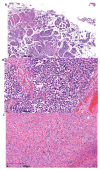Advances in Therapy for Urothelial and Non-Urothelial Subtype Histologies of Advanced Bladder Cancer: From Etiology to Current Development
- PMID: 39857670
- PMCID: PMC11761267
- DOI: 10.3390/biomedicines13010086
Advances in Therapy for Urothelial and Non-Urothelial Subtype Histologies of Advanced Bladder Cancer: From Etiology to Current Development
Abstract
Urothelial carcinoma (UC) is the most common histological subtype of bladder tumors; however, bladder cancer represents a heterogeneous group of diseases with at least 40 distinct histological subtypes. Among these, the 2022 World Health Organization classification of urinary tract tumors identifies a range of less common subtypes of invasive UC, formerly known as variants, which are considered high-grade tumors, including squamous cell, small-cell, sarcomatoid urothelial, micropapillary, plasmacytoid, and urachal carcinomas, and adenocarcinoma. Their accurate histological diagnosis is critical for risk stratification and therapeutic decision-making, as most subtype histologies are associated with poorer outcomes than conventional UC. Despite the importance of a precise diagnosis, high-quality evidence on optimal treatments for subtype histologies remains limited owing to their rarity. In particular, neoadjuvant and adjuvant chemotherapy have not been well characterized, and prospective data are scarce. For advanced-stage diseases, clinical trial participation is strongly recommended to address the lack of robust evidence. Advances in molecular pathology and the development of targeted therapies and immunotherapies have reshaped our understanding and classification of bladder cancer subtypes, spurring efforts to identify predictive biomarkers to guide personalized treatment strategies. Nevertheless, the management of rare bladder cancer subgroups remains challenging because they are frequently excluded from clinical trials. For localized disease, curative options such as surgical resection or radiotherapy are available; however, treatment options become more limited in recurrence or metastasis, where systemic therapy is primarily used to control disease progression and palliate symptoms. Herein, we present recent advances in the management of urothelial and non-urothelial bladder cancer subtypes and also explore the current evidence guiding their treatment and emphasize the challenges and perspectives of future therapeutic strategies.
Keywords: FGFR inhibitors; antibody–drug conjugates; bladder cancer; chemotherapy; immunotherapy; non-urothelial cancer; subtype histologies; urothelial cancer.
Conflict of interest statement
The authors declare no conflicts of interest.
Figures


Similar articles
-
Current Advances in the Management of Nonurothelial Subtypes of Bladder Cancer.Am Soc Clin Oncol Educ Book. 2024 Jun;44(3):e438640. doi: 10.1200/EDBK_438640. Am Soc Clin Oncol Educ Book. 2024. PMID: 38870453 Review.
-
What About Variant Histologies in Bladder Cancer?Eur Urol Focus. 2024 Mar;10(2):227-230. doi: 10.1016/j.euf.2024.05.015. Epub 2024 Jun 6. Eur Urol Focus. 2024. PMID: 38849276 Review.
-
Molecular and histopathology directed therapy for advanced bladder cancer.Nat Rev Urol. 2019 Aug;16(8):465-483. doi: 10.1038/s41585-019-0208-0. Epub 2019 Jul 9. Nat Rev Urol. 2019. PMID: 31289379 Review.
-
Variant histology in bladder cancer: diagnostic and clinical implications.Transl Cancer Res. 2020 Oct;9(10):6565-6575. doi: 10.21037/tcr-20-2169. Transl Cancer Res. 2020. PMID: 35117266 Free PMC article. Review.
-
What Is the Significance of Variant Histology in Urothelial Carcinoma?Eur Urol Focus. 2020 Jul 15;6(4):653-663. doi: 10.1016/j.euf.2019.09.003. Epub 2019 Sep 15. Eur Urol Focus. 2020. PMID: 31530497 Review.
Cited by
-
Expression Profiles of Co-Inhibitory Receptors in Non-Urothelial Bladder Cancer: Preclinical Evidence for the Next Generation of Immune Checkpoint Inhibitors.Cancers (Basel). 2025 Jul 1;17(13):2210. doi: 10.3390/cancers17132210. Cancers (Basel). 2025. PMID: 40647508 Free PMC article.
References
-
- Netto G.J., Amin M.B., Berney D.M., Compérat E.M., Gill A.J., Hartmann A., Menon S., Raspollini M.R., Rubin M.A., Srigley J.R., et al. The 2022 World Health Organization classification of tumors of the urinary system and male genital organs—Part B: Prostate and urinary tract tumors. Eur. Urol. 2022;82:469–482. doi: 10.1016/j.eururo.2022.07.002. - DOI - PubMed
Publication types
Grants and funding
LinkOut - more resources
Full Text Sources

